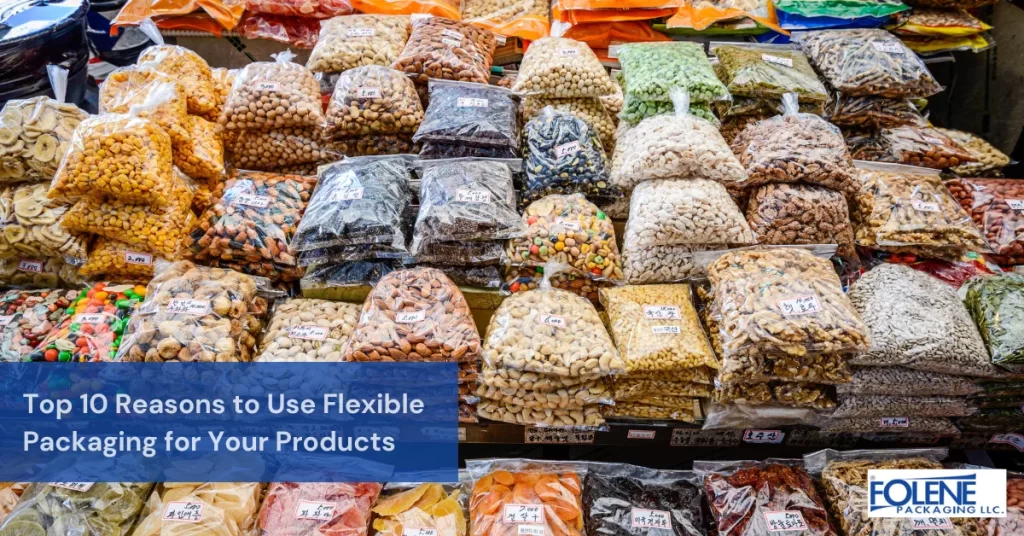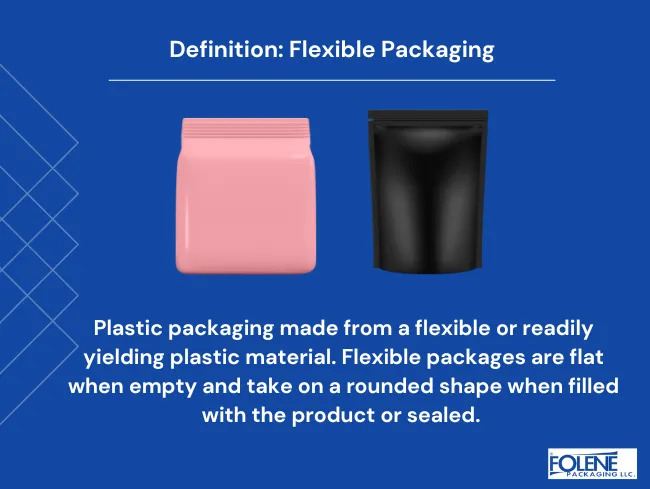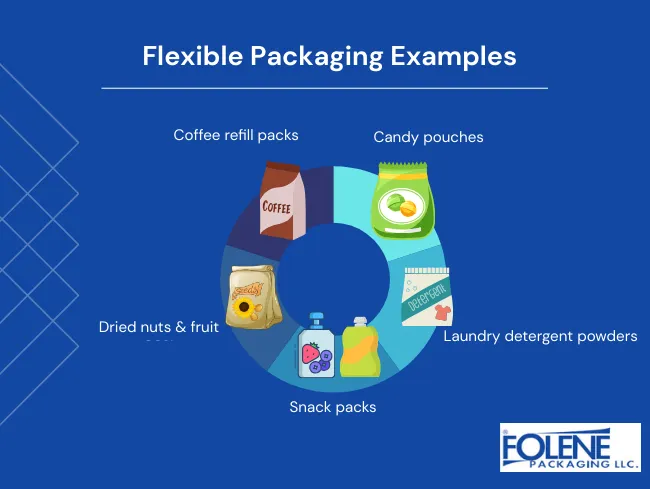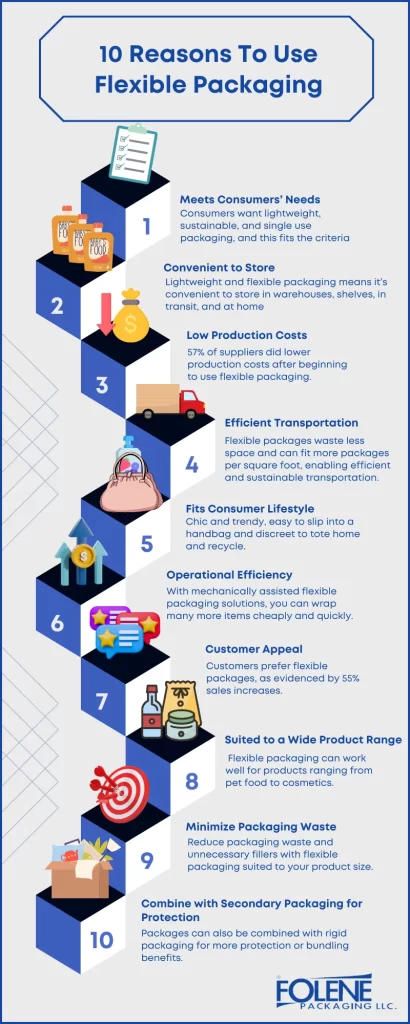
83% of suppliers enjoy using flexible packaging of some type. Packaging is a prominent aspect of materials procurement and distribution for almost every product. So, it is understandable that a Director of Material Procurement or a company owner wants to be clear about the benefits of flexible packaging in deciding whether it is the correct packaging for their products.
The best solution to meeting customer demand and ensuring quality packaging is to discover more about the advantages of flexible packaging. Flexible packaging differs from shrink wrap, which shrinks tightly over a product and is usually wrapped over a rigid container. However, the two packaging types overlap in concept, as both are flexible, which is why suppliers must understand both types of packaging. Let us know why some people prefer using flexible packaging.
What is Flexible Packaging?
“Flexible packaging” usually refers to plastic packaging in the form of a package or container constructed from a flexible or readily yielding plastic material. Flexible packages are flattish when they are empty and take on a filled shape when they are filled with the product or when they are sealed. Flexible packaging includes monolayer and multilayer packaging films of varying thicknesses and is most often used for packaging in the form of bags, pouches, and wraps.

Some packaging or sustainability organizations that define packaging types include shrink films and stretch films in the flexible packaging category. Still, others only include flexible films when they are used for specific types of packaging, such as secondary packaging or pallet wrap. Plastic films are used for reusable shopping bags, take-home and self-service packing bags, and refuse liners, and they are definitely flexible. However, when we use the term “flexible packaging,” it refers mainly to consumer items.
The Flexible Packaging Market
The flexible packaging market is growing rapidly. According to Grand Review Research, in 2023, it was valued at USD 63.46 billion. It is expected to grow at a CAGR of 4.1% from until 2030.
Consumers are demanding:
sustainable flexible packaging solutions
packaging that is lightweight, durable, and attractive.
The rise in e-commerce (especially in the post-pandemic era) reflects this growth too. The U.S. e-commerce sector grew by 14.4% in 2018, with actual sales growing by 19% in 2020. Experts believe that flexible plastic packaging market growth will be retained, with annual growth rates of around 8.99% until 2029. This is good news for each flexible packaging company as well as consumers.
It is not surprising that consumers express their needs and wants for packaging. Over 56% of Americans report that they rely more on deliveries from online purchases since the beginning of the end of 2019. Packaging must boast integrity so that there are no leaks, tears, or failures on the part of the packaging. High-quality flexible packaging solutions meet these requirements.
Examples of Flexible Packaging Products
Flexible food packaging materials include netting, paper, and aluminum, but only waterproof flexible packaging material is used in most retail flexible food packaging cases to ensure a long shelf life.

We use flexible packaging for:
Single-portion snack packets and multi-packs
Pouches for dried fruit and nuts
Family-sized sacks of detergent powder.
Colorful pouches for candies
Pallet wrap, stretch wrap
Bubble wraps for delivery of fragile products
Foil laminated packaging for coffee refill packages
Shrink film doe soft drink multipacks
Air pouches that protect small electronic items
Bundling of multipacks and promotional packs
Flexible Packaging as a Packaging Material
Flexible packaging is the product of scientific innovation, and it can help promote a circular economy to protect the environment. So, flexible packaging sustainability is a growing focal point.
People seek packaging with
optical clarity
heat resistance
recyclability
toughness
and flexible plastic packaging meets this demand with measurable benefits.
10 Reasons Manufacturers Use Flexible Packaging
Here are 10 powerful ways that flexible packaging improves the packaging scene, together with some statistics from an online brand-supplier survey (published in Packaging World Magazine):
1. Flexible packaging is truly adaptable
The flexible packaging industry constantly changes the characteristics of packaging structures to meet the needs of packers and consumers. Consumers demand increased care for sustainability, flexible and light packaging for single-use packages and products that do not require re-sealing. They can have it.
2. Flexible packaging is convenient
45% of suppliers say their consumers find flexible packaging convenient, and they would use more of it. The FPA (Flexible Packaging Association) gives examples of what makes flexible packaging convenient: it is lightweight and easy to transport, a stand-up pouch takes less space on the retail shelf, and it takes less storage space once it is in your pantry. There are many design options for opening packages, storing, and re-sealing. Consumers with limited capabilities who have mobility issues find some packaging easier to handle.
3. Flexible packaging materials often have reduced production costs
49% of brands surveyed said they would switch to flexible packaging because of the lower production cost. In practice, 57% of suppliers did lower production costs after beginning to use flexible packaging.
4. Suppliers find transportation efficiencies in the flexible packaging market
45% of suppliers see transportation efficiencies. Flexible packaging means you transport less “empty air.” Packages nestle closer in transport, meaning you can send more in every shipment.
5. Custom flexible packaging is easy to produce
It is relatively easy to satisfy consumer preferences. 39% of suppliers using flexible packaging do so because it fits consumer lifestyle trends. An example of consumer convenience is the ease of slipping a flex pack into a handbag or a jacket pocket, which is preferable to a box, and it is easier to take trash home or to fold packaging up and dispose of it.

6. Flexible packaging boasts an undeniable consumer appeal
55% of surveyed suppliers reported a sales improvement after using flexible packaging materials for more products.
7. Flexible packaging helps suppliers achieve operational efficiencies
Operational efficiency includes streamlined delivery and storage of packaging materials and the wrapped products, ease of packaging, and the ability to scale. Both small and large businesses can use this type of packaging. With a system like this, growing your business is more accessible. Compare a boutique store that hand wraps all items. With mechanically assisted flexible packaging solutions, you can wrap many more items more cheaply and quickly.
8. Flexible packaging is suitable for many different types of products
If your facility produces many different types of products, you have a one-stop packaging solution with flexible packaging. Primary packaging with flexible packaging materials for food products is standard, especially for retail food items, and also for non-food items, pet food, tobacco products, a huge range of cosmetics and personal care products, cleaning detergents, and medicinal and medical products. Flexible packaging provides lightweight and compact protection for a range of items – especially useful for products that are not evenly shaped or do not need rigid packaging.
9. Flexible packaging film minimizes waste
Exploring various types of flexible packaging can help facilities reduce weight and size, thereby eliminating the need for cardboard boxes. In numerous industries, depending on the product, suppliers can utilize flexible plastic packaging for both immediate use and external wrapping, which significantly minimizes waste.
10. Flexible packaging and secondary packaging
Flexible packaging can be used in combination with rigid containers, such as boxes, cases, or aggregation/bundling, to enhance structural stability and protect the products against external damage, to promote special offers, to rebrand and upscale plain products.
Folene Packaging’s Shrink Wrap is Flexible Packaging Is Great for Multiple Uses
Folene Packaging is a leading supplier of shrink films – high-quality, flexible packaging solutions. Folene Packaging offers polyolefin shrink films in a full range of gauges, sizes, and widths that we can customize to your packaging requirements. You can join the 31% of suppliers who expect to transition to using a higher percentage of flexible packaging in the next 5 years.
Flxtite® and Ecolene® shrink wraps are produced to order and custom-pre-perforated so that our customers can supply fresh produce, items with special deals, unitized or bundled products, and other products wrapped with integrity and confidence.
Contact Folene Packaging today to discover how our options for flexible packaging can help you streamline your packaging processes.



